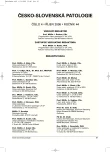Cutaneous Squamous Cell Carcinoma of Different Grades: Variation of the Expression of CD10
Authors:
A. Fernandez-Flores
Authors‘ workplace:
Service of Anatomic Pathology, Hospital El Bierzo, and the Service of Cellular Pathology, Clinica Ponferrada Spain
Published in:
Čes.-slov. Patol., 44, 2008, No. 4, p. 100-102
Category:
Original Article
Overview
Although it has been claimed that invasive cutaneous squamous cell carcinoma (SCC) does not express CD10, very few examples have been investigated regarding this matter. The claim of our study is to investigate the expression in 20 cases of SCC of different grades of differentiation. For that, we randomly selected from our archives 5 SCC-keratoacanthomatous (KA)-type; 5 SCC non-KA, well-differentiated; 5 SCC, moderately differentiated; and 5 SCC, poorly differentiated. In all these cases, we performed an immunohistochemical study for CD10. We found expression of CD10 (either stromal or cytoplasmic) in all the cases. While stromal expression (either focal or diffuse) seemed to have no relation to the degree of differentiation of the tumor, cytoplasmic expression of the marker was not found in any of the cases of the poorly-differentiated group. We conclude that 1) stromal expression of CD10 is not lost in deeply invasive SCC, as previous literature has suggested; 2) lack of cytoplasmic expression of CD10 by cutaneous SCC can be considered as an additional prognosis factor to investigate in the future; 3) our results seem contradictory to the current view that has defended atypical fibroxanthoma as an anaplastic type of SCC, since the former expresses CD10 in virtually 100 % of the cases.
Keywords:
squamous cell carcinoma – CD10 – keratoacanthoma
Sources
1. Hultgren, T.L., DiMaio, D.J.: Immunohistochemical staining of CD10 in atypical fibroxanthoma. J. Cutan. Pathol., 34 : 415-419, 2007.
2. Mirza, B., Weedon, D.: Atypical fibroxanthoma: a clinicopathological study of 89 cases. Australas. J. Dermatol., 46 : 235-238, 2005.
3. Piatelli, A., Fioroni, M., Iezzi, G, et al.: CD10 expression in stromal cells of oral cavity squamous cell carcinoma: a clinic and pathologic correlation. Oral Dis., 12 : 301-304, 2006.
4. Wagoner, J., Keehn, C., Morgan, M.B.: CD-10 immunostaining differentiates superficial basal cell carcinoma from cutaneous squamous cell carcinoma. Am. J. Dermatopathol., 29 : 555-558, 2007.
5. Weedon, D., Williamson, R., Mirza, B.: CD10, a useful marker for atypical fibroxanthoma. Am. J. Dermatopathol., 27 : 181, 2005.
6. Weedon, D., Morgan, M.B., Gross, C., Nagore, E., Yu, L.L.: Squamous cell carcinoma. In: LeBoit, P.E., Burg, G., Weedon, D., Sarasin, A.: World Health Organization Classification of Tumours. Pathology and genetics of skin tumours. IARC Press: Lyon: 20-25, 2006.
7. Yada, K., Kashima, K., Daa, T., Gitano, S., Fujiwara, S., Yokoyama, S.: Expression of CD10 in basal cell carcinoma. Am. J. Dermatopathol., 26 : 463-471, 2004.
8. Zelger, B., Soyer, H.P.: Between Scylla and Charybdis: mythology in dermatopathology. Dermatopathol. Pract. Concept., 6 : 348-355, 2000.
Labels
Anatomical pathology Forensic medical examiner ToxicologyArticle was published in
Czecho-Slovak Pathology

2008 Issue 4
Most read in this issue
- Cutaneous Squamous Cell Carcinoma of Different Grades: Variation of the Expression of CD10
- What is New in Pathology of the Thyroid Gland?
- Rafting in the Membrane. A Lesson Learnt from Lymphoproliferative Disorders
- Expression of Galectin-3, Cytokeratin 19, Neural Cell Adhesion Molecule and E-cadherin in Certain Variants of Papillary Thyroid Carcinoma
